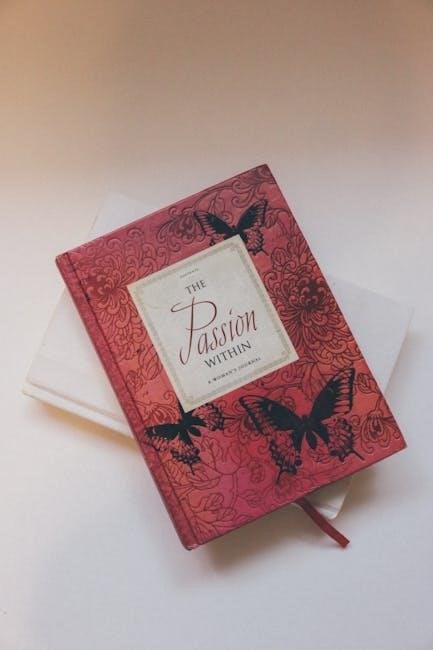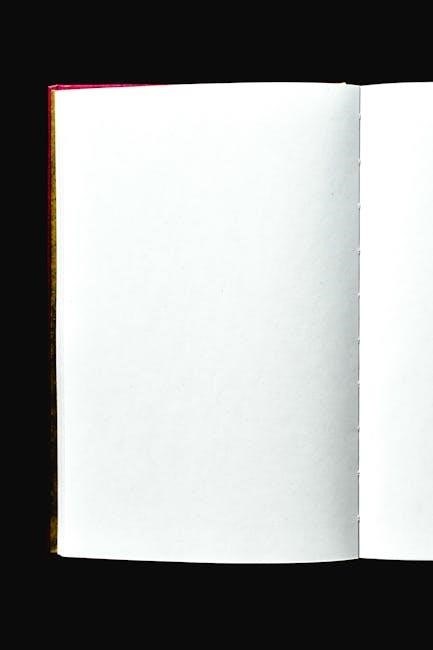Anne Frank’s diary, written between 1942 and 1944, is a poignant personal account of her life in hiding during WWII, offering profound insights into hope, resilience, and humanity.
1.1 Historical Significance of Anne Frank’s Diary
Anne Frank’s diary is a powerful primary source documenting the Holocaust, offering a deeply personal perspective on the persecution of Jews during WWII. Its raw, emotional narrative humanizes the victims, making the atrocities relatable and unforgettable. The diary serves as a vital educational tool, fostering empathy and understanding of one of history’s darkest periods. Its global impact has cemented its place as a cornerstone of Holocaust education, ensuring future generations grasp the horrors of prejudice and the importance of peace.
1.2 Overview of the Diary’s Content
Anne Frank’s diary chronicles her life from June 1942 to August 1944, detailing her experiences hiding with her family during WWII. The entries reveal her hopes, fears, and struggles, providing a vivid portrayal of daily life in the Secret Annex. Themes of identity, resilience, and the human spirit emerge, alongside candid reflections on adolescence and family dynamics. The diary captures the intimacy of her thoughts, making it a deeply personal and universal account of survival and humanity.
1.3 Why the Diary is Important Today
Anne Frank’s diary remains a vital educational tool, offering insights into the Holocaust and promoting empathy. Its universal themes of hope and resilience resonate globally, transcending time. As a historical document, it humanizes the victims of WWII, fostering understanding and tolerance. The diary’s accessibility in formats like PDF ensures its message reaches new generations, inspiring reflection on humanity’s capacity for both cruelty and courage, making it an enduring symbol of hope and the fight against intolerance.

Background of Anne Frank
Anne Frank, born in 1929 in Frankfurt, Germany, was a spirited and expressive child. Her father, Otto, was a businessman, and her mother, Edith, managed the household.
2.1 Early Life and Family
Anne Frank was born on June 12, 1929, in Frankfurt, Germany, to Otto and Edith Frank. She had an older sister, Margot. The family moved to Amsterdam in 1933 to escape Nazi persecution. Anne was a lively and curious child, often described as more outgoing than her reserved sister. Her father worked as a businessman, while her mother managed the household. This stable family life provided Anne with a nurturing environment during her early years, fostering her love for writing and expression.
2.2 The Start of WWII and Its Impact on Anne’s Life
World War II profoundly disrupted Anne Frank’s life. Following the invasion of the Netherlands in 1940, the Nazi regime enforced harsh anti-Semitic laws, restricting Jewish freedoms. Anne’s family faced increasing persecution, forcing them into hiding in 1942. The war’s onset marked the end of Anne’s carefree childhood, thrusting her into a reality of fear, confinement, and the constant threat of discovery, which she documented in her diary as a means of coping with the unimaginable circumstances.
2.3 The Gift of the Diary on Her 13th Birthday
Anne Frank received her diary on June 12, 1942, her 13th birthday, a gift that became her closest confidant. She named it Kitty, reflecting her desire for friendship and expression. The diary quickly transformed into a sanctuary where she documented her innermost thoughts, hopes, and fears. This simple notebook became a vital companion during the tumultuous years of WWII, capturing her growth and emotions as she navigated adolescence amidst unprecedented challenges.

The Diary’s Composition and Writing Style
Anne Frank wrote her diary during hiding, addressing it to “Kitty,” creating an introspective narrative filled with emotional honesty and detailed accounts of daily life, hopes, and fears.
3.1 How Anne Frank Wrote the Diary
Anne Frank began her diary in June 1942, documenting her life with candor and depth. She wrote in a red-and-white checkered notebook, later supplemented with loose pages, expressing her thoughts, emotions, and experiences while in hiding. Anne addressed each entry to “Kitty,” her imaginary friend, creating a confessional tone. Her writing evolved over time, reflecting her maturation and the harsh realities of living under Nazi occupation. The diary became her sanctuary and voice.
3.2 The Use of Imaginary Friend “Kitty”
Anne Frank’s diary entries were addressed to an imaginary friend named Kitty, a technique that provided her with a sense of companionship and trust. By personifying her diary, Anne felt comfortable sharing intimate thoughts and emotions, fostering a deep connection to her writing. Kitty symbolized the loyal listener Anne lacked in her isolated life, allowing her to express herself freely and honestly about her hopes, fears, and experiences during the Nazi occupation.
3.3 Emotional and Psychological Depth in the Diary
Anne Frank’s diary captures her inner world with remarkable emotional and psychological depth. It reveals her struggles with confinement, her longing for normalcy, and her reflections on human nature. Her entries express a range of emotions, from fear and frustration to hope and resilience, offering a candid portrayal of a teenager navigating extraordinary circumstances. The diary’s introspective nature provides profound insights into Anne’s personal growth and her ability to find light amidst darkness, resonating universally with readers.

The Secret Annex and Life in Hiding
The Secret Annex, located in Amsterdam, was Anne Frank’s refuge during WWII. It offered a confined yet crucial hiding place, documented in her diary, revealing life under Nazi persecution.
4.1 The Secret Annex: Where the Diary Was Written
The Secret Annex, located in Amsterdam, was the hiding place where Anne Frank and her family lived during WWII. This small, concealed space above her father’s office became their refuge from 1942 to 1944. The Annex, though cramped and lacking privacy, provided a safe environment for Anne to document her experiences. It was here that she wrote her diary, detailing daily life, struggles, and hopes while in hiding from Nazi persecution. The Annex played a pivotal role in preserving her story for generations.
4.2 Daily Life in Hiding
Daily life in the Secret Annex was marked by confinement, fear, and rationed resources. Anne and the others lived in cramped conditions, relying on helpers like Miep Gies for food and supplies. Privacy was scarce, and tensions often rose among the group. Despite these challenges, Anne found solace in writing, documenting her hopes, fears, and observations. The constant threat of discovery loomed, forcing them to maintain strict silence during the day and adhere to rigid routines for survival.
4.3 Relationships and Conflicts in the Annex
Life in the Secret Annex was fraught with interpersonal tensions and emotional challenges. Anne’s diary vividly captures her complex relationships with the other inhabitants, including her father’s calm leadership and her strained bond with her mother. Conflicts often arose over limited space, resources, and differing personalities, particularly with the Van Pels family. Despite these struggles, moments of camaraderie and shared hope persisted, highlighting the resilience of those living in hiding together.
Key Themes in the Diary
Anne Frank’s diary explores themes of hope, resilience, identity, and the harsh realities of war, offering a profound reflection on humanity and survival during extraordinary circumstances.
5.1 Hope and Resilience
Anne Frank’s diary embodies hope and resilience as she documented life in hiding, maintaining optimism despite the horrors of WWII. Her belief in humanity’s goodness shines through, inspiring readers with her courage and determination. The diary reflects her ability to find light in darkness, offering a timeless message of strength and perseverance. This theme remains a cornerstone of her legacy, resonating universally.
5;2 The Struggle for Identity
Anne Frank’s diary reveals her profound struggle for identity amidst adolescence and persecution. She grappled with her Jewish heritage, societal marginalization, and personal ambitions, seeking self-expression. Her writings reflect a deep exploration of her values, beliefs, and place in the world. Despite the confinement of the Secret Annex, Anne’s diary became a space for introspection, where she navigated the complexities of growing up and the oppressive realities of the Holocaust, leaving a testament to her evolving sense of self.
5.3 The Reality of War and Persecution
Anne Frank’s diary vividly captures the harsh realities of war and persecution, detailing the daily struggles of life in hiding. She writes about the constant fear of discovery, the scarcity of food, and the psychological toll of confinement. The diary also reflects the broader horrors of the Holocaust, as Anne grapples with the systematic persecution of Jews and the moral decay of humanity during WWII. Her account provides a personal yet universal perspective on one of history’s darkest periods.

The Preservation of the Diary
Miep Gies rescued Anne’s diary after the family’s arrest, preserving it until Otto Frank’s return. His dedication ensured its publication, safeguarding Anne’s legacy for generations.
6.1 Miep Gies and the Rescue of the Diary
Miep Gies, a loyal friend and helper to the Frank family, courageously retrieved Anne’s diary after the Nazis raided the Secret Annex in August 1944. Recognizing the diary’s significance, Miep preserved it, hoping to return it to Anne after the war. When Otto Frank returned, she handed it to him, ensuring the diary’s survival and its eventual publication. Miep’s bravery and compassion played a pivotal role in safeguarding Anne’s legacy.
6.2 The Discovery of the Diary After the War
After WWII, Miep Gies discovered Anne’s diary in the Secret Annex, carefully preserving it alongside loose papers. Following Anne’s tragic death, Miep returned the diary to Otto Frank, who was deeply moved by the personal and emotional entries. Recognizing its historical significance, Otto decided to fulfill Anne’s dream by publishing the diary, ensuring her voice would live on and inspire future generations to understand the horrors of the Holocaust and the power of hope.
6.3 The Role of Otto Frank in Publishing the Diary
Otto Frank, Anne’s father, was deeply moved by her diary after the war. Recognizing its historical and emotional significance, he decided to publish it to honor her memory. With the help of Miep Gies, he carefully prepared the diary for publication, ensuring its authenticity and integrity. The first edition was released in 1947, and Otto dedicated his life to promoting the diary’s message of hope and tolerance. His efforts led to its global recognition, preserving Anne’s legacy for future generations.

Publication and Translation
The diary was first published in 1947 in Dutch, then translated into English and other languages, reaching millions worldwide and becoming a celebrated literary work.
7.1 The First Publication in 1947
The diary was first published in 1947 in Dutch under the title Het Achterhuis (The Secret Annex). Otto Frank, Anne’s father, worked tirelessly to bring the diary to light after the war. The initial publication was a modest success, but it laid the foundation for the diary’s global impact. The first edition included Anne’s original entries, offering a raw and emotional glimpse into her life during WWII. This marked the beginning of the diary’s journey to becoming a worldwide phenomenon.
7.2 Translation into Multiple Languages
The diary was translated into English by B.M. Mooyaart and published by Doubleday in 1952, reaching a global audience. Its universal message resonated across cultures, leading to translations in over 70 languages. This widespread dissemination ensured Anne’s story became a global phenomenon, fostering empathy and understanding of the Holocaust’s atrocities. The translations have made the diary accessible to millions, preserving its legacy as a vital historical and literary work.
7.3 The Revised Critical Edition
The Revised Critical Edition of Anne Frank’s diary, released in 1986, includes previously omitted entries, providing deeper insights into her thoughts and feelings. This edition ensures the diary’s authenticity, preserving her original writing. It serves as a comprehensive resource for scholars and readers, enhancing understanding of her experiences. The critical edition is invaluable for Holocaust education, offering a detailed and accurate account of her life in hiding.

The Diary as a Historical Document
Anne Frank’s diary is a vital historical document, offering a personal and poignant account of life during the Holocaust. It serves as a primary source for understanding the experiences of those persecuted during WWII, providing insights into the human impact of war and genocide. The diary’s authenticity and emotional depth make it an essential tool for Holocaust education and historical awareness, preserving Anne’s legacy and the stories of millions affected by the war.
8.1 The Diary’s Role in Holocaust Education
Anne Frank’s diary is a cornerstone of Holocaust education, offering a deeply personal account of life under Nazi persecution. It humanizes the victims, fostering empathy and understanding. The diary is widely used in schools to teach historical context, human rights, and tolerance. Its accessibility in PDF format ensures it reaches a broad audience, while study guides enhance its educational value. Through Anne’s story, students connect emotionally with the Holocaust’s impact, making it a vital tool for combating prejudice and promoting peace.
8.2 The Diary’s Impact on Historical Awareness
Anne Frank’s diary profoundly enhances historical awareness by providing a personal, emotional narrative of the Holocaust. Its widespread availability in PDF format ensures global accessibility, making the atrocities of WWII relatable to diverse audiences. The diary bridges the past and present, allowing readers to connect with the experiences of those persecuted. This personal account preserves the memory of the Holocaust, ensuring future generations understand its horrors and significance. The diary’s impact lies in its ability to humanize history, making it unforgettable and poignant.
8.3 The Diary as a Primary Source
Anne Frank’s diary serves as a primary source, offering direct insights into life during WWII and the Holocaust. Its authenticity and personal perspective provide historians with a unique viewpoint. Available in PDF, it allows scholars and students to analyze the original text, enhancing historical research. The diary’s detailed accounts of daily life in hiding, emotions, and struggles make it an invaluable resource for understanding the human experience during one of history’s darkest periods. Its raw honesty and immediacy ensure its significance as a historical document.
The Diary in Popular Culture
Anne Frank’s diary has inspired numerous films, plays, and literary works, becoming a cultural phenomenon. Its universal themes continue to resonate, making it a timeless influence globally.
9.1 Film and Stage Adaptations
The Diary of Anne Frank has been adapted into numerous films and stage plays, including the famous 1959 film and the original Broadway play. These adaptations have brought Anne’s story to a global audience, preserving her legacy and ensuring her voice continues to inspire future generations. The graphic adaptation further enriches the narrative, making it accessible to modern readers. These works maintain the diary’s emotional depth and historical significance, ensuring its timeless relevance.
9.2 The Diary’s Influence on Literature
Anne Frank’s diary has profoundly influenced literature, inspiring countless authors and works. Its raw honesty and emotional depth have made it a benchmark for memoirs and Holocaust narratives. The diary’s universal themes of hope, resilience, and identity resonate across genres, shaping young adult literature and historical fiction. Its impact extends beyond WWII stories, influencing writers to explore personal and collective struggles with renewed authenticity. The diary remains a timeless literary masterpiece, continuing to inspire new generations of readers and writers alike, ensuring its enduring legacy in global literature.
9.3 The Diary’s Cultural Legacy
Anne Frank’s diary has become a cultural icon, symbolizing hope and resilience in the face of adversity. Its universal message transcends time, making it a cornerstone of Holocaust education and awareness. The diary’s emotional depth and authenticity have inspired films, plays, and adaptations, ensuring its relevance across generations. As a cultural legacy, it continues to foster empathy and understanding, reminding the world of the human cost of war and persecution. Its enduring impact solidifies its place as a vital piece of global cultural heritage.

The PDF Version of the Diary
The Diary of Anne Frank is widely available in PDF format, enabling easy access to her heartfelt story. This digital version preserves the original text’s emotional depth and historical significance, making it a popular choice for readers worldwide. The PDF format ensures the diary’s message of hope and resilience reaches new generations, maintaining its relevance in the modern era.
10.1 Availability of the Diary in PDF Format
The Diary of Anne Frank is widely available in PDF format, accessible for free download from various online platforms such as Freeditorial and the Internet Archive. Readers can easily find and download the PDF version, which includes the complete text of the diary, preserving its original content. This digital format ensures the diary’s accessibility to a global audience, making it convenient for educational purposes and personal reading. The PDF version remains a popular choice due to its portability and ease of use.
10.2 Benefits of Reading the Diary in Digital Format
Reading the Diary of Anne Frank in digital format offers numerous benefits, including accessibility and convenience. The PDF version allows readers to carry the diary on various devices, making it portable and easily accessible. Digital tools enable features like text search, zoom, and highlighting, enhancing the reading experience. Additionally, the digital format ensures the diary’s content is preserved and widely available, reaching a global audience while maintaining its historical and emotional impact.
10.3 Ethical Considerations for Downloading the PDF
Downloading the PDF of Anne Frank’s diary requires ethical awareness. Respect copyright laws and ensure the source is legitimate. The Anne Frank Fonds promotes peace and dialogue, with proceeds funding charitable initiatives. Avoid unauthorized sharing to support the foundation’s mission. Be mindful of the diary’s historical significance and use it responsibly, ensuring its message of hope and resilience continues to inspire future generations while honoring Anne’s legacy.

Educational Use of the Diary
The Diary of Anne Frank is widely used in school curricula, supported by study guides and resources, to teach empathy and historical understanding.
11.1 The Diary in School Curricula
The Diary of Anne Frank is widely incorporated into school curricula worldwide, serving as a vital tool for Holocaust education. It is often paired with study guides and resources to enhance understanding. The diary’s emotional depth and historical significance make it a cornerstone for teaching empathy, tolerance, and human rights. Many educational institutions provide PDF versions of the diary, along with supplementary materials, to facilitate classroom discussions and deeper engagement with its themes.
11.2 Study Guides and Resources
Study guides and resources for Anne Frank’s diary are widely available, offering teachers and students tools for deeper analysis. These resources include comprehension questions, historical context, and activities to foster empathy. Many guides are available in PDF format, making them easily accessible for classroom use. They often provide insights into themes like hope and resilience, while also offering discussion prompts to engage students. These resources help educators integrate the diary into curricula effectively, enhancing students’ understanding of its historical and emotional significance.
11.3 The Diary’s Role in Teaching Empathy
Anne Frank’s diary serves as a powerful tool for teaching empathy by offering a deeply personal account of her experiences during WWII. Readers connect with Anne’s emotions, fostering understanding of others’ struggles. Educators use the diary to encourage perspective-taking and reflection, helping students empathize with victims of persecution. The diary’s accessibility in PDF format makes it easier for classrooms to explore these themes, promoting a deeper emotional connection and fostering compassion among learners.

The Diary’s Enduring Legacy
Anne Frank’s diary remains a timeless testament to hope and resilience, with its PDF version ensuring accessibility, preserving her legacy for future generations to empathize and learn.
12.1 The Diary’s Universal Message
Anne Frank’s diary transcends time, offering a universal message of hope, humanity, and resilience. Its PDF format ensures global accessibility, allowing readers to connect with her experiences and reflections. The diary’s themes of hope, identity, and the struggle against oppression resonate universally, making it a powerful tool for education and empathy. It reminds us of the importance of kindness, understanding, and the human spirit’s capacity to endure even in the darkest times, inspiring future generations to embrace tolerance and peace.
12.2 The Diary’s Relevance in Modern Times
Anne Frank’s diary remains deeply relevant today, offering timeless lessons on humanity, empathy, and resilience. Its themes of hope, identity, and the struggle against injustice continue to resonate, making it a vital resource for understanding historical atrocities and promoting tolerance. The diary’s accessibility in PDF format ensures its message reaches global audiences, inspiring new generations to reflect on human rights and the importance of standing against oppression, fostering a more compassionate and informed world.
12.3 The Diary as a Symbol of Hope
Anne Frank’s diary stands as a powerful symbol of hope, even amidst the darkest circumstances. Her unwavering optimism, documented in the face of unimaginable suffering, inspires resilience and faith in humanity. The preservation of her words by Miep Gies and Otto Frank ensures her message endures, offering comfort and strength to readers worldwide. The diary’s enduring legacy reminds us of the human spirit’s capacity to find light in darkness, making it a timeless beacon of hope for future generations.
